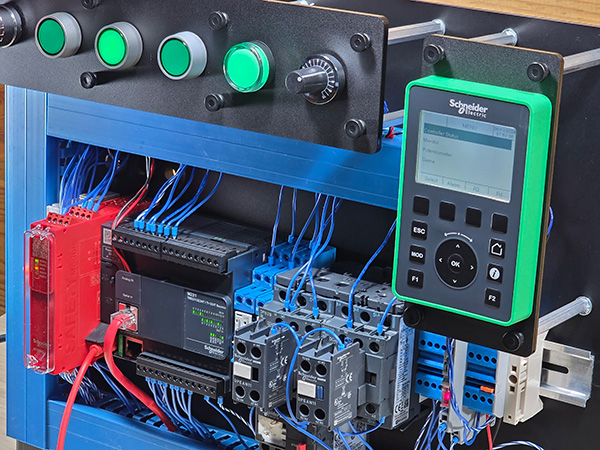The first and most important step, troubleshooting industrial control systems is an effective and downplayed skill in a technician’s arsenal.
by Aaron Dahlen, applications engineer at DigiKey
Effective troubleshooting is the technician’s core competency. This seemingly innate superpower to repair complex systems is often called “the knack.” All kidding aside, troubleshooting electronic systems is a skill that can be taught. In fact, it has been taught to generations of military technicians, some of which are likely working in your facility. Like your industry, the military has great need for skilled technicians who can quickly restore equipment to operational status.
This engineering brief is focused on the first, and arguably most important step of troubleshooting industrial control systems. It serves as a reminder that we should slow down and take time to recognize the symptoms allowing us to identify the root cause of the malfunction. We will demonstrate the procedure using the PLC trainer as shown in Figure 1.

The military has a procedure for everything, including troubleshooting. I learned to appreciate this fact over my 27-year military career where I served as a technician, technician supervisor, and officer with increasing technical and leadership responsibility. Over the years, I have seen many different troubleshooting methods. Most follow a predictable pattern, but only the Navy’s procedure captures the process beginning to end.
The 6-step procedure is outlined in the Navy Electricity and Electronics Training Series (NEETS), Module 19 – The Technician’s Handbook, NAVEDTRA 14191. This approach is every bit as applicable to our modern Programmable Logic Controller (PLC)-based industrial equipment as it was to the vacuum tube electromechanically tuned radio transmitters that were in use when the material was originally written.
The following is from the handbook:
You may have the job of maintaining or helping to maintain some electrical or electronic unit, subsystem or system.” Some of these jobs may be complex, but even a complex job can be broken down into simple steps. Basically, any repair of electric or electronic equipment should be done in the following order:
You must know your equipment to recognize a malfunction. Developing an intuitive feel for material flow, timing and sequencing is essential. After all, how can you effectively repair the equipment if you don’t know how it operates? Also, how can you keep yourself and others safe if you don’t know the system?
This can be a challenging task, as there is never enough time. Yet, it must be prioritized as extended downtime will cost your company hundreds to thousands of dollars per minute. As a technician, your reputation will be damaged if you struggle to learn the equipment’s operation when you should be performing the repair.
There is no substitute for the time and effort it takes to familiarizing yourself with the operation of the equipment.
When you respond to a service call, it’s important to pause and take a moment to properly identify all the things that are wrong with the equipment. All too often, we get tunnel vision and focus on the first symptom. While this may restore A problem, it may not restore THE problem.
System elaboration is enhanced when the Standard Operating Procedures (SOP) is used. For many systems, it is sufficient to run, or attempt to run, the equipment through a complete cycle. Obviously, there is no point operating past the point of failure. This guards against the all-too-common operator and technician errors.
Recall that the operator checklist contains the site and equipment-specific preliminary setup, operating instruction, normal shutdown and emergency instructions. A rigorous and closely related example is the aircraft specific preflight checklists used by aviators and ground crew to verify that the aircraft is ready for flight.
Tech Tip: SOP familiarization is an important aspect of the previous symptom recognition and system elaboration. If you do not have written SOPs, make it your top priority to create a properly written SOP. It’s well worth your time, as the SOP is the foundation for training new personnel and reducing equipment downtime.
The components used in industrial machinery are built with troubleshooting in mind. Rudimentary, yet essential, indicator examples include:
Once again, it’s important to know the operation and cycles associated with a machine. Without this critical information, you will not know where or when to look.
Advanced machines may include additional information such as:
The utility of these logs is directly related to the skill and imagination of the system programmers and their ability to predict everything that can go wrong with a machine. While many faults may be directly determined from the data, there is still the need for a skilled technician to properly interpret the data. There is simply no substitute for a technician’s familiarity with the machine as it operates in your facility.
Tech Tip: Interpret the input and output LEDs with caution. While they work very well for slow signals like switches or drive signals to solenoids, they do not work for fast signals or pulses. Misinterpreting of the LEDs can add considerable confusion and delay to the troubleshooting process.
Once we have carefully identified the symptoms, we can move to the next steps and isolate the fault to the system, and finally to the component(s). We acknowledge that it does take time to systematically analyze the equipment’s operation. However, this is nothing when we consider the time lost when we missed that small but critical symptom. Directed attention and a methodical 6-step troubleshooting process can save time today and in the future.
Make it part of your shop training program today to improve your team’s confidence, sharpen their skill, and improve response time.

About the Author:
Aaron Dahlen is an applications engineer at DigiKey. DigiKey is recognised as the global leader and continuous innovator in the cutting-edge commerce distribution of electronic components and automation products worldwide, providing more than 15.9 million components from over 3,000 quality name-brand manufacturers.
Visit DigiKey.com for more information.
Read more from the author:
Top Tips for Troubleshooting Electronic Systems | Automation.com, June 2025
How can generative AI simplify complex PLC programming? | Control Design, April 2025
In this episode, I sat down with Beejan Giga, Director | Partner and Caleb Emerson, Senior Results Manager at Carpedia International. We discussed the insights behind their recent Industry Today article, “Thinking Three Moves Ahead” and together we explored how manufacturers can plan more strategically, align with their suppliers, and build the operational discipline needed to support intentional, sustainable growth. It was a conversation packed with practical perspectives on navigating a fast-changing industry landscape.